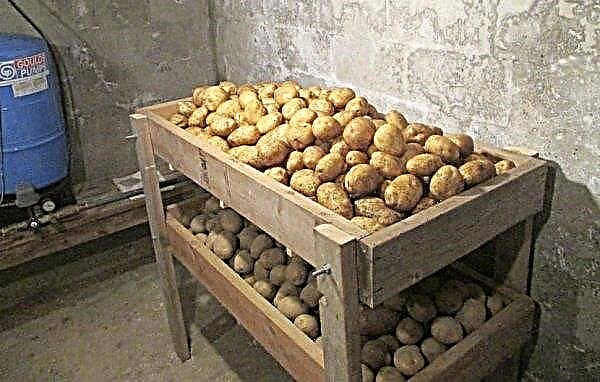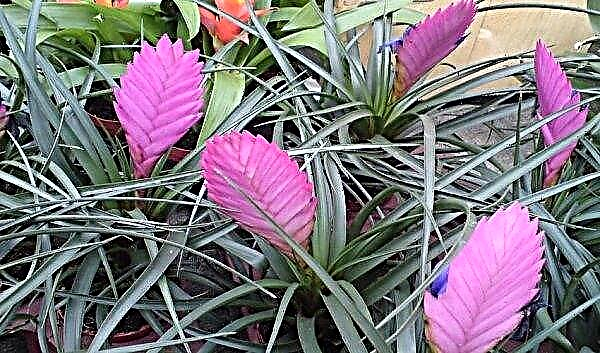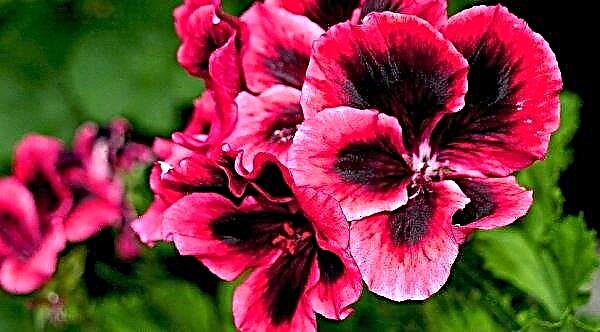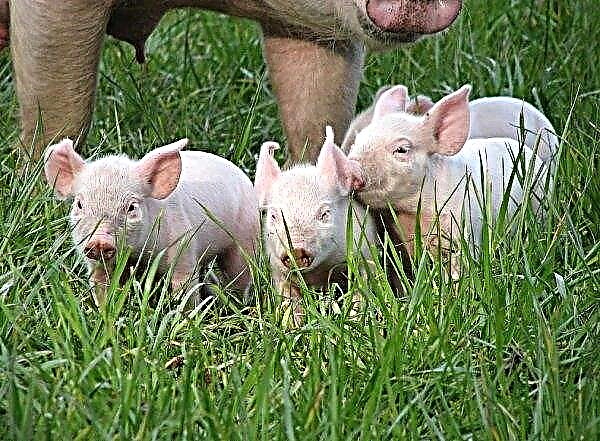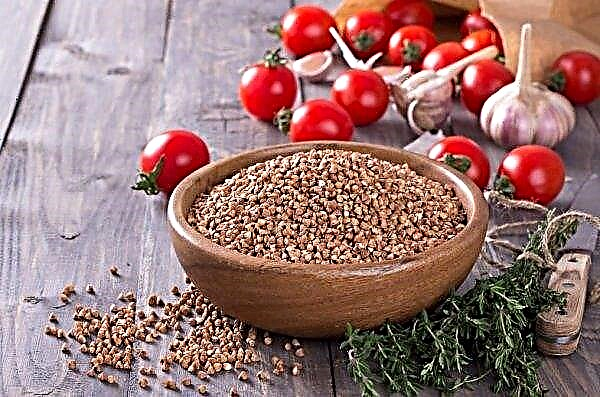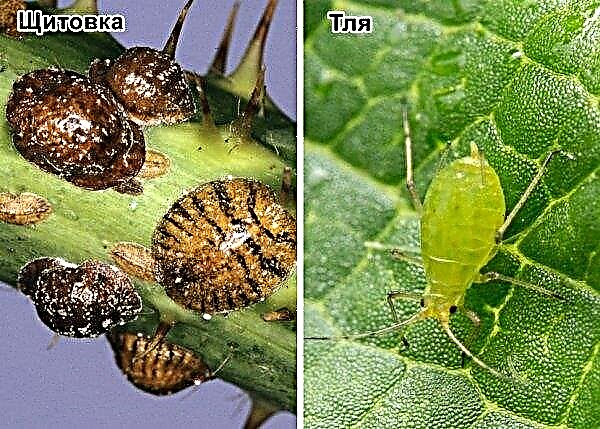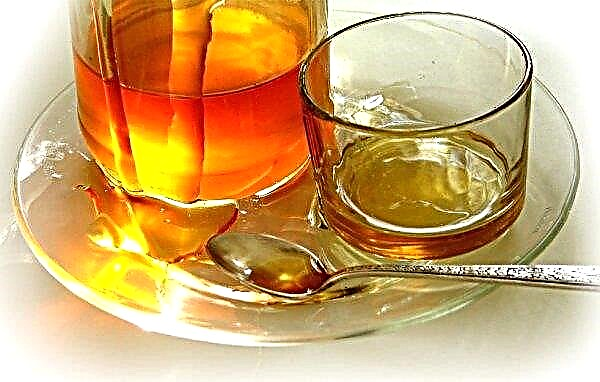A tree with green fleshy leaves that does not require special care - aeonium, can decorate the window sill of an apartment and office all year round. Rosettes of leaves and exotic inflorescences will create a cozy atmosphere, add a twist to the surrounding interior. We will consider the features of growing Eonium at home in the article.
Botanical description of the plant
In nature, aeonium grows in the Mediterranean, East Africa, in Madeira. There are succulent species with leaves of light green, bright green flowers, with a tone that changes from light to dark, almost black. Depending on the species, the tree is formed into a sphere or resembles a Japanese bonsai with an elegant star-shaped crown.
The name of the plant means "living forever." There are specimens with a height of 5 centimeters to half a meter. A stiff erect trunk contains spiral-shaped rosette of oval leaves. When they die, the leaves leave “scars” on the trunk. The leathery surface of the foliage retains and accumulates moisture.
Important! Eonium calmly tolerates a temperature of –2 ° C. The plant can survive lower thermometer values, having dry soil, but for a very short time.
The pyramidal peduncle is located at the end of the branch. When dissolved, it may resemble a small pink or yellow tree on a plate of the same color. Flowering forms can die immediately after flowering, in some species only the process with inflorescence dies.
| Root system | Well developed, branched. Perhaps the development of aerial roots in places of contact with the soil |
| Stem | Long, fleshy, tree-like |
| Leaf shape | Oval, diamond-shaped, narrowed base |
| Leaf color | Dark green, light green, turning from light in the middle to almost black on the edge |
| Flower shape | Pyramidal |
| Flower color | White, yellow, red |
| Fetus | Leaflet with brown ribbed seeds |
Important! Correctly form a bush, once a week turning the pot with a tree by 30–40°. Directional lighting promotes uniform shoot growth.
Main types
There are more than seventy decorative species of eonium, it belongs to the Tolstyankov family. Thirty-six of them are of natural origin. This evergreen plant is distinguished by color, shape of leaves, crowns. The main parameter that determines the choice of decorative aonium is appearance.
- Eonium Burchard. Homeland - Canary Islands. The central trunk is brown. The leaves are collected in rosettes with a diameter of 10 cm. The color of the foliage is green. A long peduncle blooms yellow-orange small flowers collected in a panicle.
- Eonium is decorative. The height of the bush is 20 cm. The leaves are light green with a pink tint, the socket is loose. A branchy plant, in natural conditions blooms with white-pink flowers in a panicle inflorescence. The prototype of many decorative varieties of aeonium.
- Eonium Canary. At the beginning of development, forms leafy rosettes at the surface of the soil. The leaf disc of an adult plant reaches 50-60 cm. The flower is painted in a pale green tone. The shade of leaves is lime, with a grayish pile, the form is narrowed to the base.
- Eonium is wavy. The barrel is silver. As they grow, the lower leaves fall off, leaving scars. Branching is average. The inflorescence is umbrella, dark emerald color. The sheet is glossy, in the shape of a shovel, wavy at the wide edge.
- Eonium Lindley. Succulent perennial. The bush is evergreen, very branched. All shoots become stiff with age. Shovel-like sessile leaves with short microscopic hairs have a sticky surface, pleasant aroma. Blooms in rosettes of foliage, an inflorescence of golden color.
- Eonium Haworth. Height - 30 cm. Branches, shoots appear under the outlet. Forms aerial roots at the surface of the soil. It has a dense disk of green leaves, bordered by a reddish-brown edge. Inflorescences hanging down, consist of seven buds of yellow, pink tones.
- Eonium Schwarzkopf. Bred artificially. It is distinguished by maroon, to black, narrow leaves with a green base. A tree trunk of medium branching. He feels good in an apartment, a winter garden. Popular among lovers of exotic indoor plants.
- Eonium Lemon and Lime. Hybrid, has a leafy disc up to 30 cm in diameter. The shape of the leaves is oval, pink along the edge, with a yellow-golden tint in the center. A tree-like form of medium branching.








House growing conditions
Crassulaceae tolerate the home microclimate well, are unpretentious in the care and maintenance. Evergreen trees create coziness and comfort, raise their tone in the winter, flowering succulent gives an exotic shade to the room.
Lighting
Photophilous trees are best placed on the south, southeast window sills. In the afternoon, the light should be scattered, otherwise the bush is pulled out, the foliage grows smaller, the outlet does not increase in size. In the morning you need to provide the foliage of an exotic plant with access to direct sunlight.
Ventilation
Decorative aonium is not afraid of drafts, but this need not be abused. In warm sunny weather, the succulent pot is left on the open balcony or with the windows open.
Temperature mode
The optimum temperature is + 23–25 ° С. In the summer heat, direct sunlight should be prevented, and a constant flow of fresh air should be ensured. If the balcony is on the north side, you can place a pot with succulent there.
Air humidity
Eonium retains moisture in the fleshy part of the leaf. Artificial humidification does not require. Dust can be removed from the surface of outlets with a damp cloth or in a shower at room temperature. It is important that moisture does not accumulate inside the outlets - this can lead to decay and death of the succulent.
How to care at home
Eonium is an undemanding plant, and care for it should be carried out the most ordinary: it should include watering, fertilizing, pruning and transplanting.
Did you know? Exotic succulent has such medical properties: antiseptics in the juice of the plant help fight acne, skin inflammations, abscesses. Having grown a tree-like aeonium on the windowsill, you can use it to cure burns, abrasions, relieve fever and itching after mosquito bites.
Watering
Eonium requires moderate watering, tolerates a lack of water better. Excess moisture, especially at the base of the outlet, shoots leads to disease, and can also contribute to the emergence of putrefactive bacteria, due to which the root system, and therefore the entire bush will die.
Watering frequency:
- spring, autumn - once every ten days. It is better to wait until the soil is completely dry;
- in the summer - once a week, even in the hottest time;
- in winter - once every thirty days, avoiding contact with leaf plates.
Water is used at room temperature. Water is poured around the plant, excess water from the pan must be poured. It is not necessary to spray Eonium.
Top dressing
Depending on the period, perennials are fed with special fertilizers:
- during intensive growth once a month, a mineral solution for succulents (or cacti);
- from April to September, every four weeks, an adult bush is fed with fertilizers containing nitrogen, phosphorus and potassium. The proportion is observed according to the manufacturer's recommendations (on the packaging or in the attached instructions);
- in winter, fertilizers are not applied. The plant is at rest.

Pruning
Decorative succulent resembles a bonsai tree only in appearance - you do not need to specially cut the shoots to form a crown. The appearance of inflorescences makes many species of eonium show the properties of monocarpic: the flower stalk dies. After the flowering period, the shoot must be cut off at the base to preserve the rest of the bush.
Important! Large varieties of Eonium are very whimsical in pruning. Such species are best rejuvenated in the fall.
Transfer
As it grows every two to three years, aeonium requires transplantation into a new tank. In the spring, in April, this is best done.
Process algorithm:
- Prepare a container of a larger diameter (preferably ceramic, wide, stable), fill up the drainage.
- Compose the soil: leafy soil, turf - in equal proportions, peat - 1/4 of the soil, sand, charcoal - 1/4, fall asleep on the drainage layer 3-4 cm.
- Moisten the soil so that the roots of the plant are better released.
- Get the plant, carefully check the state of the root system, carefully trim the damage.
- Set in a pot, layer the roots in soil layer by layer, slightly compacting the surface.
- Water the plant without pouring. Drain excess water from the sump.
After the fifth year, you can not transplant the tree, just add soil to the pot.
Breeding
There are two ways to reproduce aeonium: vegetative and seed. Subject to technology, the plant will grow up healthy and will not cause trouble during planting.
Cuttings
The vegetative method is used in spring and summer:
- The shoot cut off from the mother tree is rooted in a substrate of peat and sand 1: 1. The temperature should be between + 21 ° C.
- After 2-3 weeks, roots appear.
- A week after the appearance of the roots, the plant is transplanted into the ground.
You can use the leaf of the main plant. It is placed in the same soil mixture under a transparent shelter. The appearance of roots will require a longer time.
Seeds
Decorative succulent is recommended to be sown in early spring in a slightly acidic neutral peat substrate, in which sand, perlite are added:
- Sowing is carried out in rows on moist soil.
- Slightly press the grains without sprinkling on top.
- Cover with glass, a transparent dense film.
- Provide temperatures above 21 ° C.
- After the appearance of sprouts, the film is removed, a container with seedlings is installed in the illuminated place (at least 12 hours).
Important! The appearance of side shoots — A sign of the continuation of Eonium life. Otherwise, you need to restore the bush with seeds or cuttings.
Growing difficulties
Acquired aeonium must be carefully examined, excluding damage to the roots, shoots, the presence of pests. After a few days, the inspection is repeated. In the process of caring for this exotic indoor plant, lovers encounter the following problems:
In the process of caring for this exotic indoor plant, lovers encounter the following problems:
- Stretching the trunk, rapid falling of leaves. 1 reason: lack of light. It is necessary to install a pot with a plant on the illuminated windowsill, balcony, to provide maximum natural light. 2 reason: constant growth, intense flowering. Reduce watering, stop feeding, put in a cool place.
- Dense "corks" are growing on the leaves and eyelids. Reason: the microclimate of the room has changed dramatically. Jumps in temperature and humidity stimulate the strengthening of the woody part of the bush. By normalizing the temperature, reducing the frequency of watering, new seals are avoided.
- Root rot, socket at the base. There are several reasons: excess moisture, temperature increase (above + 25 ° C), an exaggerated amount of organic matter in the soil. Remedy: cut off spoiled leaves, stop watering, turn on the air conditioner to dry the air. Fundamental measure: urgent plant transplantation into new soil with lower peat content. Before planting, clean the roots and leaf disks. A heavily damaged bush is restored by cuttings.
- Dark spots appear on the leaves. Reason: prolonged exposure to direct sunlight. It is necessary to remove the plant from the windowsill in a period of high temperatures.
Did you know? The highest mountain Aeonium smithii was found at an altitude of almost 3 km.
Unpretentious and useful indoor flower Eonium will decorate any room, requiring in return minimal care and attention.




